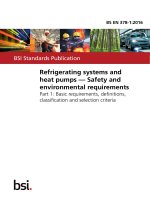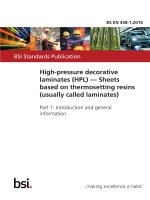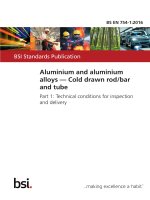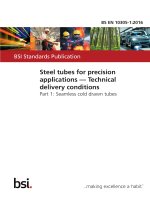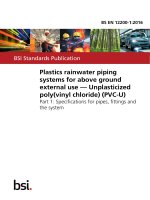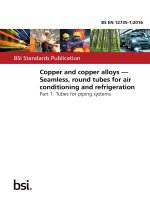Bsi bs en 61466 1 2016
Bạn đang xem bản rút gọn của tài liệu. Xem và tải ngay bản đầy đủ của tài liệu tại đây (2.47 MB, 28 trang )
BS EN 61466-1:2016
BSI Standards Publication
Composite string insulator
units for overhead lines
with a nominal voltage
greater that 1 000 V
Part 1: Standard strength classes and end fittings
BS EN 61466-1:2016 BRITISH STANDARD
National foreword
This British Standard is the UK implementation of EN 61466-1:2016. It is
identical to IEC 61466-1:2016. It supersedes BS EN 61466-1:1997 which is
withdrawn.
The UK participation in its preparation was entrusted to Technical
Committee PEL/36, Insulators for power systems.
A list of organizations represented on this committee can be obtained on
request to its secretary.
This publication does not purport to include all the necessary provisions of
a contract. Users are responsible for its correct application.
© The British Standards Institution 2016.
Published by BSI Standards Limited 2016
ISBN 978 0 580 87293 8
ICS 29.080.10
Compliance with a British Standard cannot confer immunity from
legal obligations.
This British Standard was published under the authority of the
Standards Policy and Strategy Committee on 31 August 2016.
Amendments/corrigenda issued since publication
Date Text affected
EUROPEAN STANDARD BS EN 61466-1:2016
NORME EUROPÉENNE
EUROPÄISCHE NORM EN 61466-1
ICS 29.080.10; 29.240.20 July 2016
Supersedes EN 61466-1:1997
English Version
Composite string insulator units for overhead lines with a
nominal voltage greater than 1000 V - Part 1: Standard strength
classes and end fittings
(IEC 61466-1:2016)
Éléments de chne d'isolateurs composites pour lignes Verbund-Kettenisolatoren für Freileitungen mit einer
aériennes de tension nominale supérieure à 1 000 V - Nennspannung über 1000 V - Teil 1: Genormte
Partie 1: Classes mécaniques et armatures d'extrémité Festigkeitsklassen und Endarmaturen
(IEC 61466-1:2016)
normalisées
(IEC 61466-1:2016)
This European Standard was approved by CENELEC on 2016-06-22. CENELEC members are bound to comply with the CEN/CENELEC
Internal Regulations which stipulate the conditions for giving this European Standard the status of a national standard without any alteration.
Up-to-date lists and bibliographical references concerning such national standards may be obtained on application to the CEN-CENELEC
Management Centre or to any CENELEC member.
This European Standard exists in three official versions (English, French, German). A version in any other language made by translation
under the responsibility of a CENELEC member into its own language and notified to the CEN-CENELEC Management Centre has the
same status as the official versions.
CENELEC members are the national electrotechnical committees of Austria, Belgium, Bulgaria, Croatia, Cyprus, the Czech Republic,
Denmark, Estonia, Finland, Former Yugoslav Republic of Macedonia, France, Germany, Greece, Hungary, Iceland, Ireland, Italy, Latvia,
Lithuania, Luxembourg, Malta, the Netherlands, Norway, Poland, Portugal, Romania, Slovakia, Slovenia, Spain, Sweden, Switzerland,
Turkey and the United Kingdom.
European Committee for Electrotechnical Standardization
Comité Européen de Normalisation Electrotechnique
Europäisches Komitee für Elektrotechnische Normung
CEN-CENELEC Management Centre: Avenue Marnix 17, B-1000 Brussels
© 2016 CENELEC All rights of exploitation in any form and by any means reserved worldwide for CENELEC Members.
Ref. No. EN 61466-1:2016 E
BS EN 61466-1:2016
EN 61466-1:2016
European foreword
The text of document 36/378/FDIS, future edition 2 of IEC 61466-1, prepared by IEC/TC 36
"Insulators" was submitted to the IEC-CENELEC parallel vote and approved by CENELEC as
EN 61466-1:2016.
The following dates are fixed:
• latest date by which the document has to be implemented at (dop) 2017-03-22
national level by publication of an identical national
standard or by endorsement
• latest date by which the national standards conflicting with (dow) 2019-06-22
the document have to be withdrawn
This document supersedes EN 61466-1:1997.
Attention is drawn to the possibility that some of the elements of this document may be the subject of
patent rights. CENELEC [and/or CEN] shall not be held responsible for identifying any or all such
patent rights.
Endorsement notice
The text of the International Standard IEC 61466-1:2016 was approved by CENELEC as a European
Standard without any modification.
In the official version, for Bibliography, the following note has to be added for the standard indicated :
IEC 61109:2008 NOTE Harmonized as EN 61109:2008.
2
BS EN 61466-1:2016
EN 61466-1:2016
Annex ZA
(normative)
Normative references to international publications
with their corresponding European publications
The following documents, in whole or in part, are normatively referenced in this document and are
indispensable for its application. For dated references, only the edition cited applies. For undated
references, the latest edition of the referenced document (including any amendments) applies.
NOTE 1 When an International Publication has been modified by common modifications, indicated by (mod), the relevant
EN/HD applies.
NOTE 2 Up-to-date information on the latest versions of the European Standards listed in this annex is available here:
www.cenelec.eu.
Publication Year Title EN/HD Year
IEC 60120 1984 1986
Dimensions of ball and socket couplings ofHD 474 S1
IEC 60471 1977 -
string insulator units
Dimensions of clevis and tongue couplings-
of string insulator units
3
– 2 – BS EN 61466-1:2016
IEC 61466-1:2016 © IEC 2016
CONTENTS
FOREWORD ........................................................................................................................4
1 Scope ...........................................................................................................................6
2 Normative references ....................................................................................................6
3 Mechanical and dimensional characteristics...................................................................6
4 Plan of the standard ......................................................................................................7
5 Insulator designation .....................................................................................................7
6 Marking .........................................................................................................................7
7 Composite insulator units ..............................................................................................7
Annex A (normative) Ball and socket couplings, N series .....................................................9
A.1 General ................................................................................................................9
A.2 Dimensions ...........................................................................................................9
A.3 Constructional features of the gauges ...................................................................9
A.4 Plan of the annex ..................................................................................................9
A.5 Designation ..........................................................................................................9
A.6 Gauges for ball couplings....................................................................................10
A.7 NOT GO and GO Gauges for socket couplings ....................................................14
Annex B (normative) Clevis and tongue couplings, N series ...............................................16
B.1 General ..............................................................................................................16
B.2 Dimensions.........................................................................................................16
B.3 Plan of the annex ................................................................................................16
B.4 Designation ........................................................................................................16
Annex C (normative) Y-clevis couplings .............................................................................18
C.1 General ..............................................................................................................18
C.2 Dimensions.........................................................................................................18
C.3 Plan of the annex ................................................................................................18
C.4 Designation ........................................................................................................18
Annex D (normative) Eye couplings ...................................................................................20
D.1 General ..............................................................................................................20
D.2 Dimensions.........................................................................................................20
D.3 Plan of the annex ................................................................................................20
D.4 Designation ........................................................................................................20
Bibliography .......................................................................................................................22
Figure 1 – Designation letters of couplings............................................................................8
Figure A.1 – Dimensions of NOT GO gauges for ball couplings ...........................................10
Figure A.2 – Dimensions of GO gauges for ball couplings ...................................................10
Figure A.3 – Dimensions of GO and NOT GO gauges for ball couplings...............................11
Figure A.4 – Dimensions of NOT GO gauges for ball couplings ...........................................12
Figure A.5 – Dimensions of gauges for ball coupling size 16N and 18N ..............................13
Figure A.6 – Dimensions of gauge for ball coupling size 22N..............................................13
Figure A.7 – Dimensions of NOT GO and GO gauges for socket couplings ..........................14
Figure B.1 – Dimensions of clevis and tongue couplings .....................................................17
Figure C.1 – Dimensions of Y-clevis gauges .......................................................................18
BS EN 61466-1:2016 – 3 –
IEC 61466-1:2016 © IEC 2016
Figure C.2 – Dimensions of Y-clevis couplings and gauges .................................................19
Figure D.1 – Dimensions of eye couplings...........................................................................21
Table 1 – Insulator designation .............................................................................................8
Table A.1 – Dimensions of NOT GO gauges for ball couplings.............................................10
Table A.2 – Dimensions of GO gauges for ball couplings.....................................................11
Table A.3 – Dimensions of GO and NOT GO gauges for ball couplings................................11
Table A.4 – Dimensions of NOT GO gauges for ball couplings.............................................12
Table A.5 – Dimensions of gauges for ball couplings...........................................................13
Table A.6 – Dimensions of NOT GO and GO gauges for socket couplings ...........................15
Table B.1 – Dimensions of clevis and tongue couplings.......................................................17
Table C.1 – Dimensions of Y-clevis couplings .....................................................................19
Table D.1 – Dimensions of eye couplings............................................................................21
– 4 – BS EN 61466-1:2016
IEC 61466-1:2016 © IEC 2016
INTERNATIONAL ELECTROTECHNICAL COMMISSION
____________
COMPOSITE STRING INSULATOR UNITS FOR OVERHEAD LINES
WITH A NOMINAL VOLTAGE GREATER THAN 1 000 V –
Part 1: Standard strength classes and end fittings
FOREWORD
1) The International Electrotechnical Commission (IEC) is a worldwide organization for standardization comprising
all national electrotechnical committees (IEC National Committees). The object of IEC is to promote
international co-operation on all questions concerning standardization in the electrical and electronic fields. To
this end and in addition to other activities, IEC publishes International Standards, Technical Specifications,
Technical Reports, Publicly Available Specifications (PAS) and Guides (hereafter referred to as “IEC
Publication(s)”). Their preparation is entrusted to technical committees; any IEC National Committee interested
in the subject dealt with may participate in this preparatory work. International, governmental and non-
governmental organizations liaising with the IEC also participate in this preparation. IEC collaborates closely
with the International Organization for Standardization (ISO) in accordance with conditions determined by
agreement between the two organizations.
2) The formal decisions or agreements of IEC on technical matters express, as nearly as possible, an
international consensus of opinion on the relevant subjects since each technical committee has representation
from all interested IEC National Committees.
3) IEC Publications have the form of recommendations for international use and are accepted by IEC National
Committees in that sense. While all reasonable efforts are made to ensure that the technical content of IEC
Publications is accurate, IEC cannot be held responsible for the way in which they are used or for any
misinterpretation by any end user.
4) In order to promote international uniformity, IEC National Committees undertake to apply IEC Publications
transparently to the maximum extent possible in their national and regional publications. Any divergence
between any IEC Publication and the corresponding national or regional publication shall be clearly indicated in
the latter.
5) IEC itself does not provide any attestation of conformity. Independent certification bodies provide conformity
assessment services and, in some areas, access to IEC marks of conformity. IEC is not responsible for any
services carried out by independent certification bodies.
6) All users should ensure that they have the latest edition of this publication.
7) No liability shall attach to IEC or its directors, employees, servants or agents including individual experts and
members of its technical committees and IEC National Committees for any personal injury, property damage or
other damage of any nature whatsoever, whether direct or indirect, or for costs (including legal fees) and
expenses arising out of the publication, use of, or reliance upon, this IEC Publication or any other IEC
Publications.
8) Attention is drawn to the Normative references cited in this publication. Use of the referenced publications is
indispensable for the correct application of this publication.
9) Attention is drawn to the possibility that some of the elements of this IEC Publication may be the subject of
patent rights. IEC shall not be held responsible for identifying any or all such patent rights.
International Standard IEC 61466-1 has been prepared by IEC technical committee 36:
Insulators.
This second edition cancels and replaces the first edition published in 1997. This edition
constitutes a technical revision.
This edition includes the following significant technical changes with respect to the previous
edition:
a) Addition of strength classes reflecting UHV practice;
b) Inclusion of Corrigendum 1:2008 for Y fitting hole dimensions.
BS EN 61466-1:2016 – 5 –
IEC 61466-1:2016 © IEC 2016
The text of this standard is based on the following documents:
FDIS Report on voting
36/378/FDIS 36/381/RVD
Full information on the voting for the approval of this standard can be found in the report on
voting indicated in the above table.
This publication has been drafted in accordance with the ISO/IEC Directives, Part 2.
A list of all parts in the IEC 61466 series, published under the general title Composite string
insulator units for overhead lines with a nominal voltage greater than 1 000 V, can be found
on the IEC website.
The committee has decided that the contents of this publication will remain unchanged until
the stability date indicated on the IEC website under "" in the data
related to the specific publication. At this date, the publication will be
• reconfirmed,
• withdrawn,
• replaced by a revised edition, or
• amended.
– 6 – BS EN 61466-1:2016
IEC 61466-1:2016 © IEC 2016
COMPOSITE STRING INSULATOR UNITS FOR OVERHEAD LINES
WITH A NOMINAL VOLTAGE GREATER THAN 1 000 V –
Part 1: Standard strength classes and end fittings
1 Scope
This part of IEC 61466 is applicable to composite string insulator units for a.c. overhead lines
with a nominal voltage greater than 1 000 V and a frequency not greater than 100 Hz.
It also applies to insulators of similar design used in substations or on electric traction lines.
This standard applies to string insulator units of composite type with ball, socket, tongue,
clevis, Y-clevis or eye couplings, or a combination thereof.
The object of this standard is to prescribe specified values for the mechanical characteristics
of the composite string insulator units and define the main dimensions of the couplings to be
used on the composite string insulator units in order to permit the assembly of insulators or
fittings supplied by different manufacturers and to allow, whenever practical,
interchangeability with existing installations.
It also defines a standard designation system for composite string insulator units.
NOTE 1 General definitions and methods of testing are given in IEC 61109.
NOTE 2 Only the dimensions necessary for assembly of the couplings are dealt with in this International
Standard. Properties of material and working loads are not specified. The coordination of dimensions of the end-
fittings with the strength classes is specified in Clause 7.
2 Normative references
The following documents, in whole or in part, are normatively referenced in this document
and are indispensable for its application. For dated references, only the edition cited applies.
For undated references, the latest edition of the referenced document (including any
amendments) applies.
IEC 60120:1984, Dimensions of ball and socket couplings of string insulator units
IEC 60471:1977, Dimensions of clevis and tongue couplings of string insulator units
3 Mechanical and dimensional characteristics
Composite string insulator units are standardized by the following specified characteristics:
– specified mechanical load (SML);
– standard couplings.
All dimensions are expressed in millimetres.
The dimensions apply to the finished product after any surface treatment.
BS EN 61466-1:2016 – 7 –
IEC 61466-1:2016 © IEC 2016
4 Plan of the standard
This standard includes eleven standard SML classes designated for use together with 10
different series of couplings as follows.
– Two different standard series of ball couplings, one according to IEC 60120 and one,
type N, as shown in Annex A of this standard.
– Two different standard series of socket couplings, one according to IEC 60120 and one,
type N, as shown in Annex A of this standard.
– Two different standard series of tongue couplings, one, type L, according to IEC 60471
and one, type N, as shown in Annex B of this standard.
– Two different standard series of clevis couplings, one, type L, according to IEC 60471,
and one, type N, as shown in Annex B of this standard
– One standard series of Y clevis couplings, as shown in Annex C of this standard.
– One standard series of eye couplings as shown in Annex D of this standard.
5 Insulator designation
Insulators are designated in Table 1 by letter CS followed by a number indicating the
specified mechanical load (SML) in kilonewtons. The letter B, S, T, C, Y or E or a
combination thereof which follows specifies a ball, socket, tongue, clevis, Y-clevis or eye
coupling, see Figure 1. The following figures specify the size of the coupling. When a
combination of couplings are used, the first letter shall always express the coupling on the
upper end of the insulator. The upper end of the insulator is defined in relation to the slope of
the sheds. In the case of symmetrical profile of the sheds any order of the letters is
acceptable.
As examples, possible designations could be:
CS 120 S/B16 indicates a composite insulator having a SML equal to 120 kN, a socket
coupling according to IEC 60120, size 16, at the upper end and a ball coupling according to
IEC 60120, size 16, at the other end.
CS 120 C/T19N indicates a composite insulator having a SML equal to 120 kN, a clevis
coupling according to Annex B, size 19N, at the upper end and a tongue coupling according
to Annex B, size 19N, at the other end.
Fittings of the same series conforming to different standards (e.g. IEC 60120 and Annex A of
this part of IEC 61466) should be avoided on the same insulator.
6 Marking
Each insulator shall be clearly and indelibly marked with the name or trademark of the
manufacturer, the year of manufacture, the specified mechanical load (SML) and a means
permitting identification of each of the component parts.
7 Composite insulator units
The values of the specified mechanical loads (SML) for composite string insulators together
with corresponding coupling sizes are given in Table 1.
The designation letters of the different designs of couplings which may be used in any
combination are shown in Figure 1.
– 8 – BS EN 61466-1:2016
IEC 61466-1:2016 © IEC 2016
B S T C Y E
Upper end
B S T C Y E
IEC
Figure 1 – Designation letters of couplings
Table 1 – Insulator designation
Designation Specified Ball and socket Clevis and tongue Y-clevis Eye
mechanical Annex C Annex D
IEC 60120 Annex A IEC 60471 Annex B
load size size size size size size
(SML)
– –
CS 40 40 11 – – – 16 (19) 17 (24)
13L 16N
CS 70 70 16 16N 16L 16N (19N) 19 24
16L 16N (19N) 19 24
CS 100 100 16 16N 19L 19N (22N) 22 25
(19L) 22L 22N 22 25
CS 120 120 16 18N (22L) 25L – –
28L – – –
CS 160 160 20 22N 28L – – –
32L – – –
CS 210 210 20 22N 32L – – –
36L – – –
CS 300 300 24 – –
CS 400 400 28 –
CS 420 420 28 –
CS 530 530 32 –
CS 550 550 32 –
CS 600 600 – –
NOTE 1 Non-preferred coupling sizes in brackets.
NOTE 2 Coupling size 36L is not defined in IEC 60471.
BS EN 61466-1:2016 – 9 –
IEC 61466-1:2016 © IEC 2016
Annex A
(normative)
Ball and socket couplings, N series
A.1 General
This annex applies to the couplings of composite string insulator units.
This annex defines the dimensions of a standardized series of ball and socket couplings,
which permit the replacement of existing insulator sets in accordance with North American
practice, and permits the assembly of composite insulator units and fittings supplied by
different manufacturers.
A.2 Dimensions
The dimensions for the ball and socket couplings are expressed by dimensions for the GO
and NOT GO gauges (see Figures A.1 to A.7).
All dimensions indicated in Tables A.1 to A.6 are given in millimetres and refer to the finished
product after surface treatment such as, for instance, hot dip galvanizing.
The outside dimensions of the socket have not been fixed, since they depend on the
mechanical characteristics of the material used. Only the dimensions necessary for assembly
of the couplings are dealt with in this standard.
In general, the ball is made of forged steel and the socket is made of malleable or ductile
cast iron or forged steel. However, other materials may be used if they have mechanical
characteristics corresponding to those given in Table 1 of this part of IEC 61466.
NOTE Dimensions are converted from inches.
A.3 Constructional features of the gauges
The choice of material, the hardness, the surface finish, the surface treatment and the
method of manufacture are liable to vary from one country to another. Therefore, the
following recommendations are given only for general guidance:
– the material shall be non-shrinking, oil-hardening steel;
– the Rockwell hardness number shall be 62 to 63 HRC in order to reduce deformation and
wear;
– the surface roughness shall be less than 4 µm;
– hard chromium plating can, in certain cases, increase resistance to wear.
A.4 Plan of the annex
This annex includes three standard sizes of ball and socket couplings, followed by the letter
N, which reflect the North American practice.
A.5 Designation
The ball and socket couplings are designated by the shank diameter, expressed in
millimetres, of the ball coupling, followed by the letter N.
– 10 – BS EN 61466-1:2016
IEC 61466-1:2016 © IEC 2016
d1
A.6 Gauges for ball couplings
r1 h 1
d2 h 2
h 3IEC
Figure A.1 – Dimensions of NOT GO gauges for ball couplings
Table A.1 – Dimensions of NOT GO gauges for ball couplings
Designated size of Gauge contour Dimensions according to figure A.1
ball couplings
16N Min. d1 d2 h1 r1
Nom. 15,748 –
18N Max. 15,748 – – 1,588
Min. 15,753 –
22N Nom. 17,399 20,638 14,288 –
Max. 17,399 1,588
Min. 17,404 – – –
Nom. 21,565 1,473
Max. 21,590 – – 1,600
21,615 1,727
20,638 14,288
– –
28,448 –
28,575 19,050
28,702 –
d3
r6
r5
r4 r3
α1
r2
d4
IEC
Figure A.2 – Dimensions of GO gauges for ball couplings
BS EN 61466-1:2016 – 11 –
IEC 61466-1:2016 © IEC 2016
Table A.2 – Dimensions of GO gauges for ball couplings
Designated Gauge Dimensions according to figure A.2
size of ball contour
couplings d3 d4 h2 h3 r2 r3 r4 r5 r6 α1
Min. 18,867 33,325 1,905 –
16N Nom. 18,872 33,376 14,122 30,607 23,241 6,223 2,997 3,048 2,032 11,5
Max. 18,872 33,376 2,159 –
18N Min. 18,867 33,325 14,224 30,607 23,368 6,350 3,124 3,175 1,905 –
Nom. 18,872 33,376 2,032 11,5
22N Max. 18,872 33,376 14,224 30,734 23,368 6,477 3,124 3,175 2,159 –
Min. 23,647 43,078 1,905 –
Nom. 23,673 43,104 14,122 30,607 23,241 6,223 2,997 3,048 2,032 9,5
Max. 23,698 43,129 2,159 –
14,224 30,607 23,368 6,350 3,124 3,175
14,224 30,734 23,368 6,477 3,124 3,175
18,440 36,525 32,055 3,963 5,004 –
18,491 36,576 32,106 4,089 5,055 3,962
18,542 36,627 32,156 4,216 5,105 –
d6
r8
h 4 r8 r7
h5 h5 d5
IEC
Figure A.3 – Dimensions of GO and NOT GO gauges for ball couplings
Table A.3 – Dimensions of GO and NOT GO gauges for ball couplings
Designated Gauge Dimensions according to figure A.3
size of ball contour
couplings d5 d6 r7 r8 h4 h5
Min. 31,598 –
16N Nom. 31,598 33,350 – – – 6,350
Max. 31,623 –
18N Min. 31,598 33,376 1,588 0,397 12,700 –
Nom. 31,598 6,350
22N Max. 31,623 33,376 – – – –
Min. 40,843 –
Nom. 40,869 33,350 – – – 6,350
Max. 40,894 –
33,376 1,588 0,397 12,700
33,376 – – –
43,104 – – –
43,129 0,397 0,397 12,700
43,155 – – –
– 12 – BS EN 61466-1:2016
IEC 61466-1:2016 © IEC 2016
d7
r13 h 6
r12 h 7
r10 r11
α2
r9
k
d8
IEC
Figure A.4 – Dimensions of NOT GO gauges for ball couplings
Table A.4 – Dimensions of NOT GO gauges for ball couplings
Designated Gauge Dimensions according to figure A.4
size of ball contour d7 d8 h6 h7 r9 r10 r11 r12 r13 k α2
couplings
Min. 18,923 – 12,573 25,781 23,368 3,175 – – 1,905 – –
16N Nom. 18,923 38,100 12,573 25,908 23,368 3,302 4,366 3,175 2,032 6,350 11
Max. 18,928 – 12,675 26,035 23,495 3,429 – – 2,159 – –
Min. 18,923 – 12,573 25,781 23,368 3,175 – – 1,905 – –
18N Nom. 18,923 38,100 12,573 25,908 23,368 3,302 4,366 3,175 2,032 6,350 11
Max. 18,928 – 12,675 26,035 23,495 3,429 – – 2,159 – –
Min. 23,698 47,498 16,713 36,195 32,055 3,175 4,648 – 1,905 – –
22N Nom. 23,724 47,625 16,764 36,322 32,106 3,302 4,775 4,064 2,032 6,350 9,5
Max. 23,749 47,752 16,815 36,449 32,156 3,429 4,902 – 2,159 – –
BS EN 61466-1:2016 – 13 –
IEC 61466-1:2016 © IEC 2016
M2
M 5
M 5 R R
M 4
M 3 M6 M 3
M 4
M1 M2
M1
IEC
IEC
Figure A.5 – Dimensions of gauges Figure A.6 – Dimensions of gauge
for ball coupling size 16N and 18N for ball coupling size 22N
Table A.5 – Dimensions of gauges for ball couplings
Designated Gauge Dimensions according to figures A.5, A.6
size of ball contour M1 M2 M3 M4 M5 M6 R
couplings
16N Nom. 110 111 98 49 24 – –
18N Nom. 110 113 98 49 24 – –
22N Nom. 140 70 127 64 32 15 90
NOTE The thickness of each gauge is 12,7 mm.
– 14 – BS EN 61466-1:2016
IEC 61466-1:2016 © IEC 2016
A.7 NOT GO and GO Gauges for socket couplings
D4
R7 D4 NOT GO M2
M1 M1
α3 R5 α2
D5 α4
R7 M3
H 6
H8 H5 H7
H 4
D3
R4 D1 H 2
R2 R1
R3 H 1
α1 D2
H 3
GO
IEC
Figure A.7 – Dimensions of NOT GO and GO gauges for socket couplings
Table A.6 – Dimensions of NOT GO and GO gauges for socket couplings BS EN 61466-1:2016
IEC 61466-1:2016 © IEC 2016
Designated size of Dimensions according to figure A.7
socket couplings
Gauge contour
D1 D2 D3 H1 H2 H3 R1 R2 R3 R4 α1 D4 D5 H4 H5 H6 H7 H8 M1 M2 M3 R5 R6 R7 α2 α3 α4
Min. 19,177 33,401 – 14,249 30,556 – 20,803
9,525 23,393 3,277 – – 35,662 20,828 15,824 – – – – 26,797 33,350 16,993 9,500 24,511 3,835 – – –
20,828
16N Nom. 19,177 33,401 34,138 14,249 30,607 9,144 9,525 23,393 3,277 3,175 11 35,712 20,803 15,875 12,700 9,906 8,763 19,447 26,848 33,401 17,018 9,627 24,638 3,937 11 30 45
20,828
Max. 19,202 33,452 – 14,300 30,607 – 9,652 23,520 3,378 – – 35,712 20,828 15,875 – – – – 26,848 33,401 17,018 9,627 24,638 3,937 – – –
26,899
Min. 19,177 33,401 – 14,249 30,556 – 9,525 23,393 3,277 – – 35,662 26,924 15,824 – – – – 26,797 33,350 16,993 9,500 24,511 3,835 – – –
26,949
18N Nom. 19,177 33,401 34,138 14,249 30,607 9,144 9,525 23,393 3,277 3,175 11 35,712 15,875 12,700 9,906 8,763 19,447 26,848 33,401 17,018 9,627 24,638 3,937 11 30 45
Max. 19,202 33,452 – 14,300 30,607 – 9,652 23,520 3,378 – – 35,712 15,875 – – – – 26,848 33,401 17,018 9,627 24,638 3,937 – – – – 15 –
Min. 24,613 43,155 50,673 18,593 36,449 – 6,299 32,156 5,105 – – 46,660 – 17,729 – – – 34,671 43,155 22,225 6,350 34,036 5,867 – – –
22N Nom. 24,638 43,180 50,800 18,618 36,474 13,589 6,350 32,207 5,131 4,064 9,5 46,685 20,726 17,780 – 13,360 28,575 34,696 43,180 22,352 6,401 34,087 5,918 9,5 – 45
Max. 24,663 43,205 50,927 18,644 36,500 – 6,401 32,258 5,156 – – 46,711 – 17,831 – – – 34,722 43,205 22,479 6,452 34,138 5,969 – – –
– 16 – BS EN 61466-1:2016
IEC 61466-1:2016 © IEC 2016
Annex B
(normative)
Clevis and tongue couplings, N series
B.1 General
This annex applies to the couplings of composite string insulator units.
This annex defines the dimensions of a series of clevis and tongue couplings, which permit
articulation perpendicular to the coupling pin axis to avoid bending forces in the insulator,
and permits the assembly of composite insulator units and fittings supplied by different
manufacturers.
B.2 Dimensions
All dimensions indicated in Table B.1 are given in millimetres, and refer to the finished
articles after surface treatment such as, for instance, hot dip galvanizing.
The outside dimensions of the clevis have not been fixed, since they depend on the
mechanical characteristics of the material used. Therefore the length of the coupling pin is
not fixed and, unless otherwise agreed, the coupling pin shall be delivered together with the
clevis. A locking device, such as a nut or a split pin, shall be placed to hold the pin in its
place. Only the dimensions necessary for assembly of the couplings are dealt with in this
standard.
In general, the clevis is made of malleable or ductile cast iron or forged steel and the tongue
of forged steel. However, other materials may be used if they have mechanical
characteristics corresponding to those given in Table 1.
NOTE The dimensions of this series of couplings are based on those of the IEC 60471 C series, except that they
allow articulation perpendicular to the coupling pin.
B.3 Plan of the annex
This annex includes three standard sizes of clevis and tongue couplings which reflect the
North American practice.
B.4 Designation
The clevis and tongue couplings are designated by the diameter, expressed in millimetres, of
the coupling pin which connects the clevis and the tongue, followed by the letter N.
